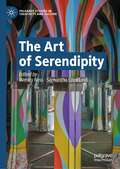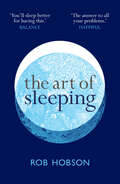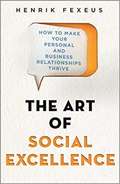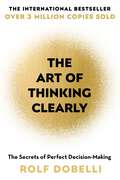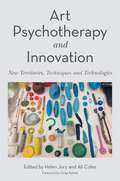- Table View
- List View
The Art of Screen Time: How Your Family Can Balance Digital Media and Real Life
by Anya KamenetzFinally, an evidence-based, don't-panic guide to what to do about kids and screens.Today's babies often make their debut on social media with the very first sonogram. They begin interacting with screens at around four months old. But is this good news or bad news? A wonderful opportunity to connect around the world? Or the first step in creating a generation of addled screen zombies?Many have been quick to declare this the dawn of a neurological and emotional crisis, but solid science on the subject is surprisingly hard to come by. In The Art of Screen Time, Anya Kamenetz--an expert on education and technology, as well as a mother of two young children--takes a refreshingly practical look at the subject. Surveying hundreds of fellow parents on their practices and ideas, and cutting through a thicket of inconclusive studies and overblown claims, she hones a simple message, a riff on Michael Pollan's well-known "food rules": Enjoy Screens. Not too much. Mostly with others.This brief but powerful dictum forms the backbone of a philosophy that will help parents moderate technology in their children's lives, curb their own anxiety, and create room for a happy, healthy family life with and without screens.
The Art of Serendipity (Palgrave Studies in Creativity and Culture)
by Samantha Copeland Wendy RossSerendipity and creativity are both broad, widely disputed, and yet consistently popular concepts which are relevant to understanding the positive aspects of our daily lives and even human progress in the arts and sciences. The chapters in this book reflects a variety of theoretical and practical approaches to serendipity in various domains, including creative problem solving, sculpture, writing, theatre and design. Chapter authors address issues such as the nature of the ‘prepared mind’, the role of accidents, serendipity as a skill or way of engaging with the world and, indeed, how serendipity works as a concept and practice in relation to the dynamic flow of the creative system. Those who wish to explore the nature of chance in art and creativity, as well as in their daily lives, will find much to ponder in these pages.
The Art of Sex Therapy Supervision
by James C. Wadley Richard SiegelThe Art of Sex Therapy Supervision is a collection of scholarly writings and case narratives that sheds light on issues that sex therapists face as supervisors or supervisees and provides techniques that can be adapted to fit clients' specific needs. Written by experts in a range of fields, this book covers a wide range of perspectives and methodologies for assisting diverse populations, including conservative Christians, LGBTQ clients, and those who exhibit out-of-control sexual behavior. It addresses individual, relational, and systemic engagement in the context of sexual function/dysfunction, and it also discusses obstructions clinicians can face when providing critical feedback to clients. This book will be useful for aspiring supervisors as well as those who supervise clinicians seeking licensure or certification.
The Art of Sex Therapy Supervision
by James C. Wadley Richard SiegelThe Art of Sex Therapy Supervision is a collection of scholarly writings and case narratives that sheds light on issues that sex therapists face as supervisors or supervisees and provides techniques that can be adapted to fit clients' specific needs. Written by experts in a range of fields, this book covers a wide range of perspectives and methodologies for assisting diverse populations, including conservative Christians, LGBTQ clients, and those who exhibit out-of-control sexual behavior. It addresses individual, relational, and systemic engagement in the context of sexual function/dysfunction, and it also discusses obstructions clinicians can face when providing critical feedback to clients. This book will be useful for aspiring supervisors as well as those who supervise clinicians seeking licensure or certification.
The Art of Silence and Human Behaviour: Interdisciplinary Perspectives
by Theodor IttenThis book examines the phenomenon of silence in relation to human behaviour from multiple perspectives, drawing on psychological and cultural-philosophical ideas to create new, surprising connections between silence, quiet and rest. Silence and being quiet are present in everyday life and in politics, but why do we talk about it so rarely? Silence can be cathartic and peaceful, but equally oppressive and unbearable. In the form of communication, we keep secrets to protect ourselves and others, but on the other hand subjects can be silenced with dictatorial posturing - a communicative display of power – and something can be literally ‘hushed up’ that needs to be disclosed. In unique and engaging style, Theodor Itten explores the multi-layered internal conversation on silence in relation to the self and emotions, demonstrating why it is sometimes necessary in our modern society. Describing and analyzing human behaviour in relation to silence, the book also draws on psychoanalytic ideas by outlining the power of silence in processing our emotions and relationships and hiding innermost feelings. With rich narrative signposts providing thought-provoking and amusing insights, and interpersonal communication examined in relation to everyday life, this is fascinating reading for students and academics in psychology, philosophy, cultural studies, and related areas.
The Art of Silence and Human Behaviour: Interdisciplinary Perspectives
by Theodor IttenThis book examines the phenomenon of silence in relation to human behaviour from multiple perspectives, drawing on psychological and cultural-philosophical ideas to create new, surprising connections between silence, quiet and rest. Silence and being quiet are present in everyday life and in politics, but why do we talk about it so rarely? Silence can be cathartic and peaceful, but equally oppressive and unbearable. In the form of communication, we keep secrets to protect ourselves and others, but on the other hand subjects can be silenced with dictatorial posturing - a communicative display of power – and something can be literally ‘hushed up’ that needs to be disclosed. In unique and engaging style, Theodor Itten explores the multi-layered internal conversation on silence in relation to the self and emotions, demonstrating why it is sometimes necessary in our modern society. Describing and analyzing human behaviour in relation to silence, the book also draws on psychoanalytic ideas by outlining the power of silence in processing our emotions and relationships and hiding innermost feelings. With rich narrative signposts providing thought-provoking and amusing insights, and interpersonal communication examined in relation to everyday life, this is fascinating reading for students and academics in psychology, philosophy, cultural studies, and related areas.
The Art of Sleeping: The Secret To Sleeping Better At Night For A Happier, Calmer More Successful Day
by Rob Hobson‘An insomniac’s dream buy!’ THE SUN ‘If you lie awake wondering how to get a good night’s sleep, this could be the answer to all your problems.’ HAPPIFUL The secret to sleeping better at night for a happier, calmer, more successful day.
The Art of Social Excellence: How to Make Your Personal and Business Relationships Thrive
by Henrik FexeusHenrik Fexeus uses his expert psychology knowledge to teach the reader how to hone their social skills, perfect for fans of Dale Carnegie.Research has increasingly shown that nonverbal communication prowess is absolutely essential in seemingly unrelated areas of our lives (investment decisions, salary levels, etc.). However, as our society becomes more modernised and we incorporate new forms of technology into our daily interactions, we are becoming less and less capable of understanding one another as we should.In The Art of Social Excellence, Henrik Fexeus combines his own expert knowledge as a mentalist with psychology studies to create a complete guide to social interaction. He covers it all: from overcoming your conversational fears in a large group of people, to excelling in the workplace, to winning an argument with your partner. He breaks down various rhetorical strategies in detail and provides helpful steps and checklists for the reader to check their progress in a social encounter.Anyone who has ever felt awkward or misunderstood in social situations will benefit from reading this book, and with proper implementation of Fexeus' principles, can achieve superior social skills.
The Art of Strategic Therapy
by Jay Haley Madeleine Richeport-HaleyExperience the art of Jay Haley's strategic therapy as he personally utilizes a variety of techniques in treating depression, violence, and psychosis with couples, children, families and various ethnic groups.Visit www.haley-therapies.com for additional resources by Jay Haley, including live videos of the pioneering therapist in action.
The Art of Strategic Therapy
by Jay Haley Madeleine Richeport-HaleyExperience the art of Jay Haley's strategic therapy as he personally utilizes a variety of techniques in treating depression, violence, and psychosis with couples, children, families and various ethnic groups.Visit www.haley-therapies.com for additional resources by Jay Haley, including live videos of the pioneering therapist in action.
The Art of Teaching: Experiences of Schools
by Cedric CullingfordA central dilemma for teachers is finding ways to deal with the multiple perspectives and demands of pupils, parents, school management, and external forces. The Art of Teaching explores the tension between teaching and learning that all teachers face. Presenting a series of insights into the art of teaching from the perspectives of those individuals most closely involved in the schooling process, the book explores pupil voice in schools, and experiences of teaching and learning from the pupil perspective. Providing an opportunity for self reflection, the book also examines teachers’ relationships with parents, external agencies and their attitudes towards pupils. Subjects covered include: What pupils think of teachers Teacher’s views of themselves and self reflection School hierarchies and the ethos of inspection Using pupil insights to inform learning strategies Essential reading for all teachers and students, this book offers a unique insight into school relationships and structures, giving readers an awareness of what is like to be a teacher. Professor Cedric Cullingford’s many books include "The Causes of Exclusion" (Taylor and Francis) and "How Pupils Cope with School" (Cambridge Scholar’s Press).
The Art of Teaching: Experiences of Schools
by Cedric CullingfordA central dilemma for teachers is finding ways to deal with the multiple perspectives and demands of pupils, parents, school management, and external forces. The Art of Teaching explores the tension between teaching and learning that all teachers face. Presenting a series of insights into the art of teaching from the perspectives of those individuals most closely involved in the schooling process, the book explores pupil voice in schools, and experiences of teaching and learning from the pupil perspective. Providing an opportunity for self reflection, the book also examines teachers’ relationships with parents, external agencies and their attitudes towards pupils. Subjects covered include: What pupils think of teachers Teacher’s views of themselves and self reflection School hierarchies and the ethos of inspection Using pupil insights to inform learning strategies Essential reading for all teachers and students, this book offers a unique insight into school relationships and structures, giving readers an awareness of what is like to be a teacher. Professor Cedric Cullingford’s many books include "The Causes of Exclusion" (Taylor and Francis) and "How Pupils Cope with School" (Cambridge Scholar’s Press).
The Art of the Interesting: What We Miss in Our Pursuit of the Good Life and How to Cultivate It
by Lorraine BesserPhilosopher and popular Middlebury professor Dr. Lorraine Besser reveals the missing third piece in our search for the Good Life—what she calls The Interesting—and teaches us how to cultivate it in our lives. Do you know anyone who's truly living The Good Life? Traditionally, philosophers and psychologists have thought of the Good Life in terms of happiness or meaning, or some combination of both. But, if it&’s really that simple, if all you need is more happiness or meaning to get to the Good Life, why aren&’t more of us achieving that truly &“good&” life? You&’ve hit all the traditional markers, jumped on the happiness train, committed to a gratitude practice, sought purpose in your work, and yet The Good Life you&’re seeking, is still out of reach. Emerging research is revealing that there is, in fact, more to the good life than the current —and even ancient—conversation suggests. This has been identified as psychological richness. Dr. Lorraine Besser, a founding investigator in these studies, shows how psychological richness helps to make our Good Lives more interesting. Interesting experiences captivate our minds, engage our thoughts and emotions, and often change our perspective. What&’s interesting is different for everyone, and everyone can obtain and strengthen the skills necessary to access the interesting. In this illuminating book, you&’ll take a deeper dive into the ways that you can cultivate the interesting in your everyday life, including: How to develop an interesting mindset How to harness the power of novelty How to turn obstacles into adventures Through delightful stories, powerful tools, and new mindsets, you&’ll learn how to &“keep it interesting.&” Whether you feel like something is missing from your life, or you&’re yearning for more, Besser's groundbreaking manifesto will guide you toward a fuller, more satisfying life.
The Art of Thinking Clearly: Better Thinking, Better Decisions
by Rolf DobelliTHE SUNDAY TIMES BESTSELLERTHE TIMES BESTSELLERGUARDIAN BESTSELLER AMAZON TOP TEN BESTSELLERTHE SECRETS OF PERFECT DECISION-MAKINGHave you ever... Invested time in something that, with hindsight, just wasn't worth it?Overpaid in an Ebay auction? Continued doing something you knew was bad for you?Sold stocks too late, or too early? Taken credit for success, but blamed failure on external circumstances? Backed the wrong horse?These are examples of cognitive biases, simple errors we all make in our day-to-day thinking. But by knowing what they are and how to spot them, we can avoid them and make better choices - whether dealing with a personal problem or a business negotiation; trying to save money or make money; working out what we do or don't want in life, and how best to get it.Already an international bestseller, THE ART OF THINKING CLEARLY is essential reading for anyone with important decisions to make. It reveals, in 100 short chapters, the most common errors of judgement, and how to avoid them. Simple, clear and always surprising, this indispensable book will change the way you think and transform your decision-making - at work, at home, every day.
The Art of Winning: Ten Lessons in Leadership, Purpose and Potential
by Dan CarterDan Carter is a widely hailed as one of the most elite and successful professional rugby players in the world.After retiring from a sport he played for 32 years, he set out to inspire the next generation of leaders to create purposeful impact, joining the Oxford Foundry - Oxford University's Entrepreneurial Institute, founded by LinkedIn co-found Reid Hoffman - as its first ever Leader in Practice. Now, in a follow-up to his bestselling 2015 autobiography, he answers timeless questions for aspiring leaders everywhere. Why is the team more important than the individual? How do you navigate the transition from player to leader? How should we respond when confidence is eclipsed by doubt, when circumstances get the better of us, when setbacks derail us? How can we remain humble and grounded when we're winning - and how can we keep on winning, even when a loss may be just around the corner?Full of inspiring personal stories of both victories and setbacks, the greatest rugby sportsman reflects on his career, shares his own secrets of high performance, and reveals the art of exceeding your highest expectations.
Art, Play, and Narrative Therapy: Using Metaphor to Enrich Your Clinical Practice
by Lisa B. MoschiniArt, Play, and Narrative Therapy shows mental health professionals how the blending of expressive arts, psychotherapy, and metaphorical communication can both support and enhance clinical practice. This book illuminates the ways in which metaphorical representations form who we are, how we interact, and how we understand our larger environment. Author Lisa Moschini explains how to couple clients’ words, language, stories, and artwork with treatment interventions that aid empathic understanding, promote a collaborative alliance, and encourage conflict resolution. Chapters include numerous illustrations, exercises, and examples that give clinicians inspiration for both theoretical and practical interventions.
Art, Play, and Narrative Therapy: Using Metaphor to Enrich Your Clinical Practice
by Lisa B. MoschiniArt, Play, and Narrative Therapy shows mental health professionals how the blending of expressive arts, psychotherapy, and metaphorical communication can both support and enhance clinical practice. This book illuminates the ways in which metaphorical representations form who we are, how we interact, and how we understand our larger environment. Author Lisa Moschini explains how to couple clients’ words, language, stories, and artwork with treatment interventions that aid empathic understanding, promote a collaborative alliance, and encourage conflict resolution. Chapters include numerous illustrations, exercises, and examples that give clinicians inspiration for both theoretical and practical interventions.
Art, Psychoanalysis, and Adrian Stokes: A Biography
by Janet SayersIllustrated with Barbara Hepworth's abstract stone carving, with other works of art, and with fascinating vignettes from Adrian Stokes's writing, this biography highlights his revolutionary emphasis on the materials-led inspiration of architecture, sculpture, painting, and the avant-garde creations of the Ballets Russes. In also detailing Stokes's role as catalyst of the transformation of St Ives in Cornwall into an internationally-acclaimed centre of modern art, and his falling in love again in his early forties, this biography shows how Stokes used all these experiences, together with his many years of psychoanalytic treatment by Melanie Klein, in forging insights about ways the outer world gives form to the inner world of fantasy and imagination.
Art, Psychoanalysis, and Adrian Stokes: A Biography
by Janet SayersIllustrated with Barbara Hepworth's abstract stone carving, with other works of art, and with fascinating vignettes from Adrian Stokes's writing, this biography highlights his revolutionary emphasis on the materials-led inspiration of architecture, sculpture, painting, and the avant-garde creations of the Ballets Russes. In also detailing Stokes's role as catalyst of the transformation of St Ives in Cornwall into an internationally-acclaimed centre of modern art, and his falling in love again in his early forties, this biography shows how Stokes used all these experiences, together with his many years of psychoanalytic treatment by Melanie Klein, in forging insights about ways the outer world gives form to the inner world of fantasy and imagination.
Art Psychotherapy (Wiley Series On Personality Processes Ser.)
by Harriet WadesonThe long-awaited new edition of the landmark text defining art therapy Art therapists use the creative process and the issues that surface during art therapy to help their clients increase insight and judgment, cope with stress, work through traumatic experiences, increase cognitive abilities, have better relationships with family and friends, and simply enjoy the life-affirming pleasures of the creative experience. In this highly anticipated revision of the definitive text on art therapy, author and pioneer art therapist Dr. Harriet Wadeson examines the clinical considerations, education, history, and application of art therapy treatment programs for an array of presenting problems. Reflecting current DSM updates since the first edition's publication, the Second Edition has been completely updated, with nine new chapters on trauma, crisis, multicultural considerations, community art therapy, and more. Illustrated with over 150 works of art from clients as well as the author's own personal artwork, and packaged with a companion CD-ROM, which includes more than 100 full-color versions of the illustrations in the book, Art Psychotherapy, Second Edition is a comprehensive guide to the theory and practice of art therapy. Written by one of the most established experts in the field, this book will be informative for practicing art therapists, other mental health practitioners looking to incorporate art therapy into their mental health practice, students in these disciplines, and those interested in entering the art therapy profession. Note: CD-ROM/DVD and other supplementary materials are not included as part of eBook file.
Art Psychotherapy
by Harriet WadesonThe long-awaited new edition of the landmark text defining art therapy Art therapists use the creative process and the issues that surface during art therapy to help their clients increase insight and judgment, cope with stress, work through traumatic experiences, increase cognitive abilities, have better relationships with family and friends, and simply enjoy the life-affirming pleasures of the creative experience. In this highly anticipated revision of the definitive text on art therapy, author and pioneer art therapist Dr. Harriet Wadeson examines the clinical considerations, education, history, and application of art therapy treatment programs for an array of presenting problems. Reflecting current DSM updates since the first edition's publication, the Second Edition has been completely updated, with nine new chapters on trauma, crisis, multicultural considerations, community art therapy, and more. Illustrated with over 150 works of art from clients as well as the author's own personal artwork, and packaged with a companion CD-ROM, which includes more than 100 full-color versions of the illustrations in the book, Art Psychotherapy, Second Edition is a comprehensive guide to the theory and practice of art therapy. Written by one of the most established experts in the field, this book will be informative for practicing art therapists, other mental health practitioners looking to incorporate art therapy into their mental health practice, students in these disciplines, and those interested in entering the art therapy profession. Note: CD-ROM/DVD and other supplementary materials are not included as part of eBook file.
Art Psychotherapy and Innovation: New Territories, Techniques and Technologies
by Debra Kalmanowitz Helen Hawthorne Erin Partridge Nick Barnes Alex Burr Ella Bryant Neil Winter Natalia Higginson Tsun-wei Lily Hsu Wei-Wen Chan Chia-Yu Liu Trupti Magecha Anastasia Ostrowski Hae Won Park Cynthia Breazeal Daisy Rubinstein Megan Tjasink Poppy Stevens Mira Yoon Daphna Arbell Kehila Hwee Hwee Loo Sara Powell Natalia Carlier Gomez Abby Dougherty Natalie Rae CarltonArt psychotherapists worldwide collaborate in this volume of clinical practice examples of innovation, featuring work with diverse client groups, locations and new technologies. The chapters integrate theory, ethical considerations and the global contemporary landscape, to expand our thinking on the growing potential of art psychotherapy.
Art, Psychotherapy and Psychosis
by Katherine Killick Joy SchaverienArt, Psychotherapy and Psychosis reveals the unique role of art therapy in the treatment of psychosis. Illustrating their contributions with clinical material and artwork created by clients, experienced practitioners describe their work in a variety of settings. Writing from different theoretical standpoints they reflect the current creative diversity within the profession and its links with psychotherapy, psychoanalysis, analytical psychology and psychiatry.In part I specific issues involved in working with psychosis are explored. These include discussion of the therapeutic relationship, the process of symbolisation, the nature and meaning of art made by psychotic patients and the interplay between words and pictures. Part II recounts the history of art therapy and psychosis, tracing its origins in art, to its present-day role as a respected treatment in psychiatric, community and therapeutic settings.Art, Psychotherapy and Psychosis extends the existing theory, develops analytical approaches in art psychotherapy and offers innovative perspectives for students and practitioners on the treatment of borderline states as well as psychosis.
Art, Psychotherapy and Psychosis
by Katherine Killick Joy SchaverienArt, Psychotherapy and Psychosis reveals the unique role of art therapy in the treatment of psychosis. Illustrating their contributions with clinical material and artwork created by clients, experienced practitioners describe their work in a variety of settings. Writing from different theoretical standpoints they reflect the current creative diversity within the profession and its links with psychotherapy, psychoanalysis, analytical psychology and psychiatry.In part I specific issues involved in working with psychosis are explored. These include discussion of the therapeutic relationship, the process of symbolisation, the nature and meaning of art made by psychotic patients and the interplay between words and pictures. Part II recounts the history of art therapy and psychosis, tracing its origins in art, to its present-day role as a respected treatment in psychiatric, community and therapeutic settings.Art, Psychotherapy and Psychosis extends the existing theory, develops analytical approaches in art psychotherapy and offers innovative perspectives for students and practitioners on the treatment of borderline states as well as psychosis.
Art Psychotherapy Groups: Between Pictures and Words
by Val Huet Sally SkaifeA growing number of art therapists are also trained in group analytic psychotherapy. This book explores the new theories and models for practice arising from the merging of these two disciplines.Contributors ask whether a model can be applied universally to art therapy group work with diverse client groups. They present in-depth case studies looking at work with the following:-* children* drug and alcohol abusers* forensic patients* patients on acute psychiatric wards* the cognitively-impaired elderly* institutionalised patients moving into the communityA common theme which emerges is that the physical use of art materials and the space of the art room offer a possibility for communication of feelings which is not possible in purely verbal groups. This allows clients who would not normally be considered for group therapy to benefit from a psychodynamic group process.

